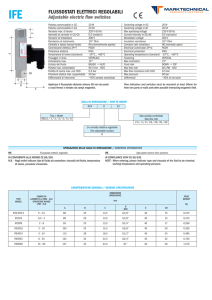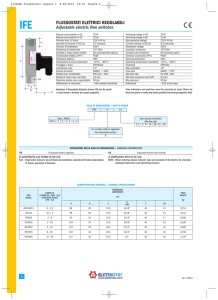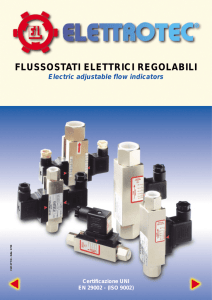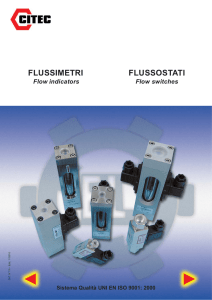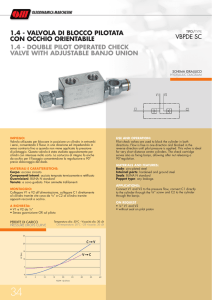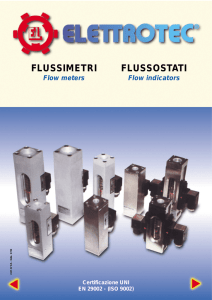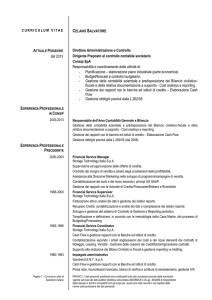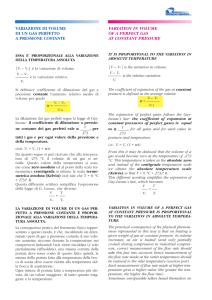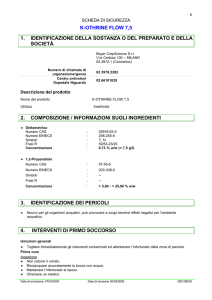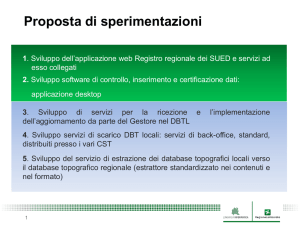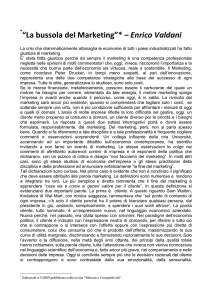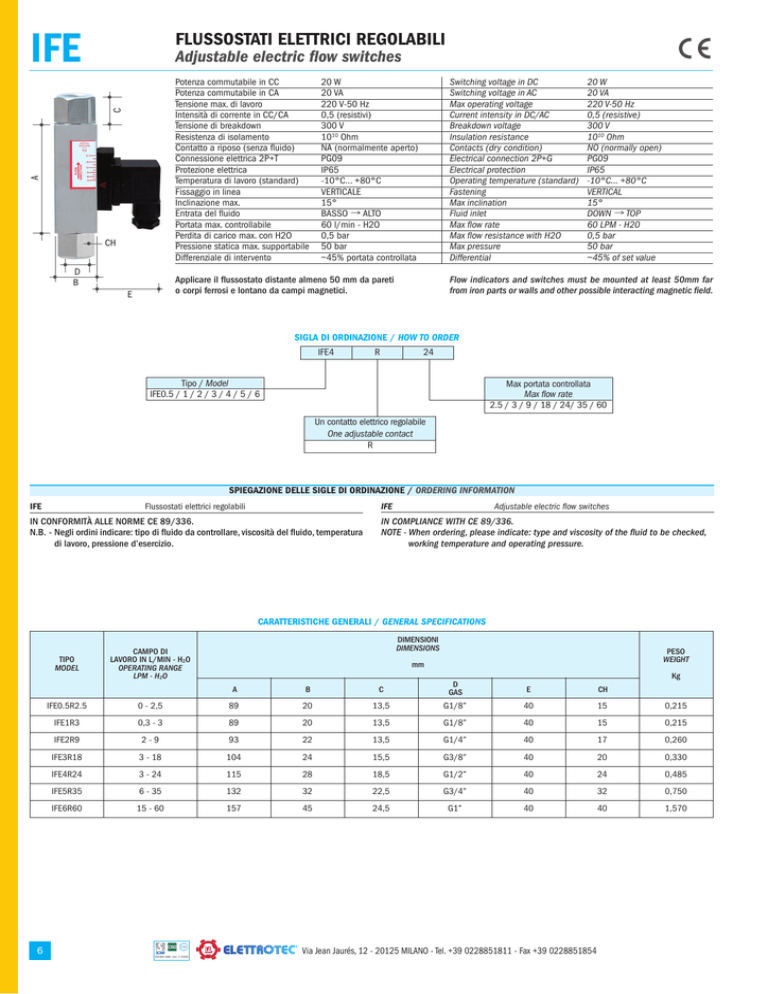
IFE
FLUSSOSTATI ELETTRICI REGOLABILI
Adjustable electric flow switches
A
C
Potenza commutabile in CC
Potenza commutabile in CA
Tensione max. di lavoro
Intensità di corrente in CC/CA
Tensione di breakdown
Resistenza di isolamento
Contatto a riposo (senza fluido)
Connessione elettrica 2P+T
Protezione elettrica
Temperatura di lavoro (standard)
Fissaggio in linea
Inclinazione max.
Entrata del fluido
Portata max. controllabile
Perdita di carico max. con H2O
Pressione statica max. supportabile
Differenziale di intervento
CH
D
B
20 W
20 VA
220 V-50 Hz
0,5 (resistivi)
300 V
1010 Ohm
NA (normalmente aperto)
PG09
IP65
-10°C... +80°C
VERTICALE
15°
BASSO → ALTO
60 l/min - H2O
0,5 bar
50 bar
~45% portata controllata
Switching voltage in DC
Switching voltage in AC
Max operating voltage
Current intensity in DC/AC
Breakdown voltage
Insulation resistance
Contacts (dry condition)
Electrical connection 2P+G
Electrical protection
Operating temperature (standard)
Fastening
Max inclination
Fluid inlet
Max flow rate
Max flow resistance with H2O
Max pressure
Differential
Applicare il flussostato distante almeno 50 mm da pareti
o corpi ferrosi e lontano da campi magnetici.
E
20 W
20 VA
220 V-50 Hz
0,5 (resistive)
300 V
1010 Ohm
NO (normally open)
PG09
IP65
-10°C... +80°C
VERTICAL
15°
DOWN → TOP
60 LPM - H20
0,5 bar
50 bar
~45% of set value
Flow indicators and switches must be mounted at least 50mm far
from iron parts or walls and other possible interacting magnetic field.
SIGLA DI ORDINAZIONE / HOW TO ORDER
IFE4
R
24
Tipo / Model
IFE0.5 / 1 / 2 / 3 / 4 / 5 / 6
Max portata controllata
Max flow rate
2.5 / 3 / 9 / 18 / 24/ 35 / 60
Un contatto elettrico regolabile
One adjustable contact
R
SPIEGAZIONE DELLE SIGLE DI ORDINAZIONE / ORDERING INFORMATION
IFE
IFE
Flussostati elettrici regolabili
IN CONFORMITÀ ALLE NORME CE 89/336.
N.B. - Negli ordini indicare: tipo di fluido da controllare, viscosità del fluido, temperatura
di lavoro, pressione d’esercizio.
Adjustable electric flow switches
IN COMPLIANCE WITH CE 89/336.
NOTE - When ordering, please indicate: type and viscosity of the fluid to be checked,
working temperature and operating pressure.
CARATTERISTICHE GENERALI / GENERAL SPECIFICATIONS
TIPO
MODEL
DIMENSIONI
DIMENSIONS
CAMPO DI
LAVORO IN L/MIN - H2O
OPERATING RANGE
LPM - H2O
PESO
WEIGHT
mm
Kg
A
B
C
D
GAS
E
CH
IFE0.5R2.5
0 - 2,5
89
20
13,5
G1/8”
40
15
0,215
IFE1R3
0,3 - 3
89
20
13,5
G1/8”
40
15
0,215
IFE2R9
2-9
93
22
13,5
G1/4”
40
17
0,260
IFE3R18
3 - 18
104
24
15,5
G3/8”
40
20
0,330
IFE4R24
3 - 24
115
28
18,5
G1/2”
40
24
0,485
IFE5R35
6 - 35
132
32
22,5
G3/4”
40
32
0,750
IFE6R60
15 - 60
157
45
24,5
G1”
40
40
1,570
6
Via Jean Jaurés, 12 - 20125 MILANO - Tel. +39 0228851811 - Fax +39 0228851854
ISO 9001:2008 - Cert. n° 0158/5
FLUSSIMETRI E FLUSSOSTATI VISIVI ED ELETTRICI
REGOLABILI TIPO IF
ADJUSTABLE ELECTRIC FLOW INDICATORS AND
SWITCHES WITH OR WITHOUT VISUAL INDICATION
TYPE IF
IMPIEGO
USE
Flussimetri e flussostati vengono normalmente impiegati per controllare il
passaggio di un fluido o di un gas in un circuito e avere una semplice indicazione di portata oppure, nelle versioni dotate di contatto, trasmettere un
segnale elettrico di allarme a distanza, su un quadro di controllo, qualora
si registri una variazione della intensità del flusso.
Sono particolarmente indicati per l’utilizzo negli impianti di carico e scarico
acqua, olio, gas, nonché nei circuiti di raffreddamento, pompe di calore, riscaldatori, saldatrici, trasformatori, scambiatori di calore, compressori, industria chimica, farmaceutica, alimentare, ecc.
The Elettrotec flow switches and indicators are generally used to monitor the
flow of a fluid or a gas in a circuit and have a simple reading of the flow or,
when equipped with contact, send an electric alarm signal to a remote
board in case of flow decreasing under the set value.
They are normally used in circulation plants, fuel and water outlets, oil and
gas systems as well as in cooling circuits, heat pumps, welding machines,
heaters, transformers, heat exchangers, compressors, food, chemical and
pharmaceutical industry.
FUNZIONAMENTO
OPERATION
I flussostati visivi ed elettrici regolabili sono costituiti da un corpo, due
flange di collegamento, un otturatore con magnete permanente, un tubo di
vetro Pirex con scala graduata, un tubo di guida dell’otturatore con sezioni
di passaggio variabili, guarnizioni di tenuta, un cursore con contatti magnetici e un connettore per il collegamento elettrico.
Il flusso fluido o gassoso, entrando dal basso verso l’alto nel flussostato,
montato verticalmente, sospinge l’otturatore verso l’alto, lungo il tubo con
sezione variabile di passaggio, portandolo a posizionarsi nel campo indicato dalla scala graduata ricavata sul tubo di vetro Pirex dove, in corrispondenza dell’estremità superiore “color rosso” sarà possibile leggere il
valore della portata istantanea presente nel circuito.
L’otturatore, immerso nella vena fluida, è libero di muoversi in assenza di
attriti meccanici e, grazie al campo magnetico generato dal magnete alloggiato nel suo interno, aziona il contatto elettrico di allarme; mediante il
cursore mobile con indice di riferimento è possibile posizionare il contatto
in corrispondenza della portata da controllare, segnata sulla targhetta a
lato. Il movimento del cursore deve essere bloccato mediante il grano posto
sotto il connettore. Impiegare fluidi privi da impurità.
The electric and adjustable flow switches with visual indication have been
designed with a rugged body, two connection flanges, a shutter with
permanent magnet, a Pirex tube marked with a graduated scale, a guide
tube of the shutter with variable flow rate areas, seals, a cursor with
magnetic contacts and a connector for circuitry.
Liquids or gases flow upwards from the bottom of the device, fixed in the
upright position, pushing the shutter along the
guide tube with variable areas and setting it at a flow rate value readable
on the graduated scale marked on the glass tube by the red index line. In
this way it is possible to read the instant flow in the circuit.
The shutter, plunged in the fluid, can freely move without mechanical
friction and, thanks to the magnetic field produced by the magnet housed
inside, let operate the electric alarm contact. By means of the movable
cursor, equipped with a reference index, the contact can be placed by the
flow rate to be checked, shown on the label at the side.
The cursor movement must be fixed by turning the dowel under the
connector.
Use fluids having no kind of impurity.
CARATTERISTICHE
FEATURES
Massima sicurezza di funzionamento per la completa assenza di attriti delle
parti in movimento. Regolazione del punto di intervento su tutta la scala.
Robustezza dovuta alla particolare compattezza costruttiva. Insensibilità
alla pressione del fluido.
Highest operation safety thanks to the frictionless parts in movement.
Adjustment of the intervention point at any value indicated on the scale.
Particular rugged construction.
Not affected by fluid pressure.
COMPONENTI
COMPONENTS
Corpo e flangia di collegamento in lega leggera anodizzata, ottone nichelato o acciaio inox aisi 304, tubo dosatore e otturatore in ottone cromato
o acciaio inox aisi 304 con magnete permanente, tubo di vetro Pirex con
scala graduata, guarnizioni di tenuta in gomma nitrilica, FKM o EPDM.
Anodized light alloy, nickel-plated brass or 304 stainless steel body and
flange, chromium-plated brass or 304 stainless steel tube and shutter with
permanent magnet, Pirex glass tube with graduated scale, nitrile rubber,
FKM or EPDM seal gaskets.
TABELLA DI CONVERSIONE DELLE PORTATE ACQUA/ARIA
PER FLUSSOSTATI E FLUSSIMETRI IF..V-VE-E
Tipo
Acqua l/min
Aria Nm3/h
IF1..
0,1 - 01
0,2 - 2
IF2..
0,2 - 03
0,35 - 5
IF3..
1 - 06
2 - 10
IF4..
2 - 16
3,5 - 29
IF5..
5 - 60
10 - 110
CONVERSION TABLE OF WATER/AIR FLOW RATE RELATIVE TO
IF..V-VE-E FLOW INDICATORS AND SWITCHES
Model
Water LPM
Air Nm3/h
IF1..
0,1 - 01
0,2 - 2
IF2..
0,2 - 03
0,35 - 5
IF3..
1 - 06
2 - 10
IF4..
2 - 16
3,5 - 29
IF5..
5 - 60
10 - 110
MOLLE DI COMPENSAZIONE DA UTILIZZARE
PER FLUIDI PIÙ VISCOSI DELL’ACQUA
SPRINGS TO BE USED WITH FLUIDS MORE VISCOUS THAN WATER
• Molla M6
• Molla M7
• Molla M8
• Molla M9
• Molla M10
• Spring M6
• Spring M7
• Spring M8
• Spring M9
• Spring M10
Viscosità fino a 14,4 cSt.
Viscosità fino a 39,8 cSt.
Viscosità fino a 70,4 cSt.
Viscosità fino a 119,2 cSt.
Viscosità fino a 205,6 cSt.
APPLICARE IL FLUSSOSTATO DISTANTE ALMENO 50 mm DA PARETI O
CORPI FERROSI E LONTANO DA CAMPI MAGNETICI.
ATTENZIONE: la combinazione tra la tensione e la corrente di commutazione non deve mai superare la potenza commutabile indicata nei
dati tecnici.
Viscosity up to
Viscosity up to
Viscosity up to
Viscosity up to
Viscosity up to
14,4
39,8
70,4
119,2
205,6
cSt.
cSt.
cSt.
cSt.
cSt.
FLOW INDICATORS AND SWITCHES MUST BE MOUNTED AT LEAST 50mm
FAR FROM IRON PARTS OR WALLS AND OTHER POSSIBLE INTERACTING
MAGNETIC FIELD.
WARNING: any combination of the switching voltage and current must
not exceed the given rated power.
FLUSSOSTATI ELETTRICI REGOLABILI TIPO IFE
ADJUSTABLE ELECTRIC FLOW SWITCHES IFE
IMPIEGO I flussostati IFE vengono normalmente impiegati per controllare il
passaggio di un fluido in un circuito e trasmettere un segnale elettrico ON-OFF
di allarme a distanza su un quadro di controllo, qualora si registri una variazione dell’intensità del flusso. Sono particolarmente indicati per l’utilizzo negli
impianti di carico e scarico acqua e olio, nonché nei circuiti di raffreddamento,
pompe di calore, riscaldatori, saldatrici, trasformatori, scambiatori di calore,
compressori, impianti chimici, farmaceutici, alimentari, ecc.
FUNZIONAMENTO I flussostati elettrici regolabili serie IFE sono costituiti da
un corpo, attacchi di collegamento, un otturatore con magnete permanente e
sezioni di passaggio variabili, guarnizioni di tenuta, un cursore con contatti magnetici e da un connettore per il collegamento elettrico. L’otturatore, immerso
nella vena fluida, è libero di muoversi in assenza di attriti meccanici e, grazie
al campo magnetico generato dal magnete alloggiato nel suo interno, aziona
il contatto elettrico di allarme; mediante il cursore mobile con indice di riferimento è possibile posizionare il contatto in corrispondenza della portata da
controllare, segnata sulla targhetta a lato. Il movimento del cursore può essere
bloccato mediante il grano posto sotto il connettore. Impiegare fluidi privi di impurità.
CARATTERISTICHE Massima sicurezza di funzionamento per la completa
assenza di attriti delle parti in movimento. Regolazione del punto di intervento
su tutta la scala. Robustezza dovuta alla particolare compattezza costruttiva. Insensibilità alla pressione del fluido.
COMPONENTI Corpo e raccordi in ottone nichelato, otturatore in ottone
cromato con magnete permanente, guarnizioni di tenuta in gomma nitrilica,
cursore portacontatti, connettore di collegamento e rispettive viti di fissaggio in
materiale termoplastico.
MONTAGGIO Installare il flussostato IF...E lontano da campi magnetici ed
evitare di fissarlo contro pareti ferromagnetiche che possono smagnetizzare il
magnete interno all’otturatore interrompendone il funzionamento. È opportuno
fissare il flussostato in posizione verticale con l’entrata del fluido dal basso
verso l’alto. Il flusso da controllare deve essere esente da impurità in sospensione che possono altrimenti bloccare l’otturatore. Per regolare il contatto elettrico di allarme portata spostare il cursore portacontatti verso l’alto e poi
abbassarlo lentamente fino a fare chiudere il contatto reed posto nel suo interno. Infine bloccarlo con l’apposito grano di fissaggio.
USE
The IFE flow switches are generally used to monitor the flow rate of a
fluid in a circuit and send an electric ON-OFF alarm signal to a remote board
in case of flow decreasing under the set value.
These flow switches are normally used in circulation plants, fuel and water
outlets, oil systems as well as in cooling circuits, heat pumps, welding
machines, heaters, transformers, heat exchagers, compressors, food, chemical
and pharmaceutical industry.
OPERATION These electric and adjustable flow switches have been designed
with a rugged body, connections, a shutter with permanent magnet and variable
flow areas, seals, a cursor with magnetic contacts and a connector for circuitry.
The shutter, plunged in the fluid, can freely move without mechanical friction
and, thanks to the magnetic field produced by the magnet housed inside, let
operate the electric alarm contact. By means of the movable cursor, equipped
with a reference index, the contact can be placed by the flow rate value to be
checked, shown on the label at the side. The cursor movement must be fixed
by turning the dowel under the connector. Use fluids having no kind of impurity.
FEATURES Highest operating safety due to frictionless parts in movement.
Adjustment of the intervention point at any value indicated on the scale.
Particular rugged construction. Not affected by fluid pressure.
COMPONENTS Nickel-plated brass body and connections, chromium-plated
brass shutter with permanent magnet, nitrile rubber gaskets, switch housing
cursor, connector and screws in thermoplastic material.
INSTALLATION
Mount the IF...E flow switch far from any interacting
magnetic fields and avoid to fix it against iron walls that could degauss the
magnet housed inside the shutter and affect the correct working. It is advisable
to fix the device in vertical position to let the fluid flow upwards. The fluid to be
monitored must be absolutely free from any impurity that could prevent the
shutter working correctly. To adjust the electric alarm contact shift the cursor
upwards and then slowly bring it down to let the reed contact housed inside
close. Then secure it with the proper fixing dowel.
INFORMAZIONI TECNICHE
TECHNICAL INFORMATION
CIRCUITI PROTETTIVI PER CONTATTI REED
PROTECTIVE CIRCUITS FOR REED CONTACTS
I valori relativi alla portata
della corrente e della tensione, indicati nei dati tecnici si riferiscono a carichi
resistivi puri. Spesso, tuttavia, si devono controllare carichi induttivi o capacitivi, oppure si devono azionare lampade. Per situazioni di questo tipo è necessaria qualche considerazione circa l’opportunità di proteggere i contatti reed dai
picchi di tensione o di corrente.
1) Carichi induttivi In presenza di circuiti alimentati con corrente continua, la protezione del contatto è relativamente facile. Si deve collegare in parallelo al carico un diodo semiconduttore come indicato nella fig. 1 (vedi pagina
seguente). Le polarità devono essere collegate in modo che il diodo si blocchi
con il normale voltaggio di esercizio e sempre in corto circuito nel caso di inversione delle polarità. Quando si commutano dei carichi induttivi alimentati
con corrente alternata non si può utilizzare un diodo, bisogna usare un dispositivo di soppressione dell’arco. Di solito si tratta di un collegamento RC parallelo al commutatore e quindi in serie con il carico, come da fig. 2 (vedi pagina
seguente). La dimensione del soppressore di arco può essere determinata dal
monogramma di fig. 3 (vedi pagina seguente).
2) Carichi capacitivi e lampade Al contrario di quanto avviene con i carichi induttivi, con i carichi capacitivi e con lampada si hanno elevate scariche
di corrente che possono provocare guasti immediati, e persino la saldatura dei
contatti. Quando si commutano dei condensatori caricati o dei condensatori di
linea, si ha un’immediata scarica la cui intensità dipende dalla portata e dalla
lunghezza dei carichi. La corrente di scarica di picco è limitata da un resistore
in serie con il condensatore, come è indicato nella fig. 4 (vedi pagina seguente).
La dimensione del resistore sarà determinata in base alle possibilità esistenti
nell’ambito di un particolare circuito. In ogni caso, dovrebbe essere il più grande
possibile per limitare lo scarico di corrente entro limiti accettabili. Quanto detto
vale anche per il carico con condensatori. Per quanto riguarda i circuiti con
condensatori ad elevata scarica di corrente, andrebbero usati i circuiti come da
fig. 5 (vedi pagina seguente), con R1 o R2.
Le lampade al tungsteno aumentano da 5 a 15 volte la corrente nominale durante i primi 10millisecondi di funzionamento. Queste elevate scariche di corrente possono essere limitate entro valori accettabili con l’aggiunta di resistenze
collegate in serie per limitare la corrente.
Un’altra possibilità consiste nel collegare una resistenza in parallelo con il commutatore in modo che i filamenti delle lampade vengano pre-riscaldati proprio
sino al punto in cui non diventano incandescenti quando vengono accese. Entrambi i metodi comportano una perdita di corrente.
The current and voltage
switch rating given in the technical data refer to pure resistive loads. However,
inductive or capacity loads are often to be checked or lamps are to be
switched. In this case it is necessary to protect the reed contacts against peaks
in voltage or current.
1) Inductive loads The contact protection is relatively easy with direct
current. A semiconductor diode is to be connected in parallel to the load, as
indicated in picture 1 (next page). Polarities must be connected in a way the
diode would simply jam under normal operating voltage and always shortcircuit the opposing voltage that occurs with the opening of the switch. When
inductive loads, fed with alternating current, are switch-ed, it is not to be used
a diode but an arc-suppression unit. An RC link connected in parallel to the
switch, and therefore in series with the load, is usually applied, see picture 2
(next page). The arc-suppression size can be taken from a chart, as from picture
3 (next page).
2) Capacity loads and lamp switching-on Contrary to inductive loads,
high current inrushes occur with capacitive loads or switched-on lamps, and
that may lead to early switch failure or even to welding of contacts.
When charged capacitors or cable capacitors are switched, a sudden discharge
occurs, the intensity of which depends on the capacity and length of the
connecting cables. A resistor in series with the capacitor limits the current
peaks or discharges, as shown in picture 4 (next page).
The size of the resistor depends on the different possibilities offered by a
particular circuit. In any case the resistor should be the biggest possible to
limit the current discharge within accept-able values. The same applies also to
charging of capacitors.
Protection against high current discharges from capacitors should be provided
by means of the circuit R1 or R2 or both, as shown in picture 5 (next page).
Tungsten lamps increase from 5 to 15 times the rated current during their first
ten milliseconds of working.
These high current inrushes can be limited to an acceptable value connecting
in series current-limiting resistance or
connecting in parallel to the switch a resistance, so that the lamp filaments
would be preheated just to the point they would not become incandescent
when turned-on.
Both protecting solutions imply a power loss.

